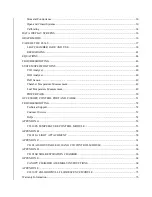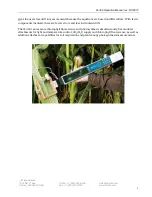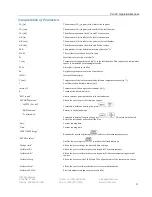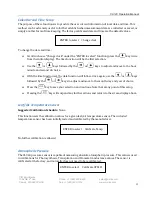
CI-340 Operation Manual rev. 6/7/2017
CID Bio-Science
1554 NE 3
rd
Ave
Camas, WA 98607, USA
Phone: +1 (360) 833-8835
Fax: +1 (360) 833-1914
[email protected]
www.cid-inc.com
4
When initially performing a measurement, the CI-340 takes gas from the inlet or intake where air is
coming in through a filter. This air is moved through the pump and then next through the flow sensor
where the flow rate is regulated. After that, because the device is measuring in, inlet gas is directed
through the analyzer and then enters into the leaf chamber. The gas leaves the leaf chamber and is
directly exhausted.
The CI-
340 will measure the “in” for approximately 20 seconds plus the number of seconds entered for
the time interval. The extra 20 seconds allows the machine to clean out any residual gases that are in
the analyzer and to let the analyzer stabilize. Every time something is changed on the CI-340, the
stability is disturbed and the machine should be allowed a few seconds to stabilize. Once the “in” is
measured, all the valves switch to other position. Now the inlet gas goes straight to the leaf chamber,
and the output of the leaf chamber now goes to the analyzer to be measured before it gets exhausted.
Figure 1 illustrates the pathways of air flow through the CI-
340 during both “in” and “out”
measurements.
CAUTION:
When attaching a pressurized gas source to the external inlet, use a three-way fitting
(which is provided with each instrument) to allow excess gas to escape. Excess pressure may blow
out internal fittings and tubing, or damage the pump. Do not use a three-way fitting for non-
pressurized gas sources.
Main Components of Gas Exchange Systems
There are several main components making up the CI-340. Each of these components needs to be
functioning properly in order for the combined operation of all the components to produce stable and
accurate photosynthetic measurements. Components include the gas exchange or leaf chamber, the
infrared gas analyzer, the pump and mass airflow sensor, and the flow sensor or meter. Other basic
components include filters, gas lines, the display (LCD) screen, the keypad, and the power source or
battery. The CI-340 utilizes a built-in microprocessor to regulate the airflow rate, which is determined
by the user in the range of 0.2 lpm to 1.01 lpm, with the default setting at 0.3 lpm.
Several things can affect the performance and accuracy of photosynthesis measurement systems, such
as leaf chamber architecture and leaf chamber seal quality. The CI-340 has various leaf chamber
attachments for use with different leaf types and whole plants. The leaf chambers are made from
materials which have a low adsorption of water and CO
2
in order to provide tight seals and accurate
readings. A common problem with infrared gas analyzers is poor discrimination between CO
2
and H
2
O
(water vapor) because both gasses absorb energy at similar wavelengths. This problem is relieved by
using a desiccant to dry the gas sample to a stable (constant) water vapor content before reaching the
analyzer. The CI-340 also allows precise control of temperature, CO
2
concentration, humidity and light
when taking measurements through use of the accessories. The CI-340 also includes computer
software programs giving the user instant access to data in the field. This allows the user to detect and
correct any errors during the measurement.
Highlights of CI-340
The CI-340 is the most sensitive and most stable hand-held IRGA photosynthesis system. It is also
small and very light-weight. The CI-340 is easy to calibrate, remains stable longer after calibration and
warms up faster than previous IRGA models. This is because the CI-340 incorporates a single IRGA to
perform both intake and outtake measurements. Using a single IRGA to measure (versus two or more),
Summary of Contents for CI-340
Page 3: ......








































